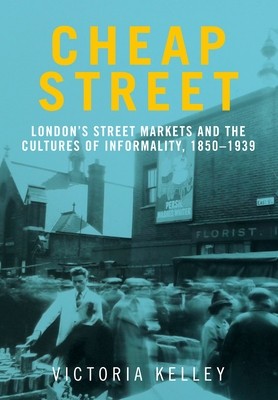
- We will send in 10–14 business days.
- Author: Victoria Kelley
- Publisher: Manchester University Press
- ISBN-10: 1526163853
- ISBN-13: 9781526163851
- Format: 17 x 24.4 x 1.6 cm, softcover
- Language: English
- SAVE -10% with code: EXTRA
Reviews
Description
London's street markets - Petticoat Lane, Berwick Street, Lambeth Walk - are iconic locations: Cheap street tells their history, and that of the people who bought and sold there. From the 1850s anything that could be bought in a shop could also be bought in London's street markets, which were the butcher, baker, greengrocer, provision merchant, haberdasher, tailor and furnisher of the working-class city. They sat uncomfortably on the edge of the law, barely tolerated by authorities that did not quite know whether to admire them for their efficient circulation of goods, or to despise them for their unregulated and 'low' character. They were the first recourse of immigrants looking to earn a living, and of privileged observers seeking a voyeuristic glimpse of street life.
London's street markets have too often been overlooked, viewed as anomalous amongst the sophisticated consumer institutions of the modern city, the department stores and West-End shops. Cheap street shows how the street markets, as an emanation of the informal economy that flourishes in the interstices of urban life, adapted nimbly to urban growth and contributed to consumer modernity. In doing so, they propagated myths about what it meant to live in London and be a Londoner.
Cheap street analyses the street markets through their legal and economic informality, material culture, sensory affects, and performative character, using rich and varied documentary and visual evidence. It reshapes the interpretation of London's urban geographies and consumer cultures, offering new insights to amateurs, students and scholars of London's history.
EXTRA 10 % discount with code: EXTRA
The promotion ends in 20d.01:02:35
The discount code is valid when purchasing from 10 €. Discounts do not stack.
- Author: Victoria Kelley
- Publisher: Manchester University Press
- ISBN-10: 1526163853
- ISBN-13: 9781526163851
- Format: 17 x 24.4 x 1.6 cm, softcover
- Language: English English
London's street markets - Petticoat Lane, Berwick Street, Lambeth Walk - are iconic locations: Cheap street tells their history, and that of the people who bought and sold there. From the 1850s anything that could be bought in a shop could also be bought in London's street markets, which were the butcher, baker, greengrocer, provision merchant, haberdasher, tailor and furnisher of the working-class city. They sat uncomfortably on the edge of the law, barely tolerated by authorities that did not quite know whether to admire them for their efficient circulation of goods, or to despise them for their unregulated and 'low' character. They were the first recourse of immigrants looking to earn a living, and of privileged observers seeking a voyeuristic glimpse of street life.
London's street markets have too often been overlooked, viewed as anomalous amongst the sophisticated consumer institutions of the modern city, the department stores and West-End shops. Cheap street shows how the street markets, as an emanation of the informal economy that flourishes in the interstices of urban life, adapted nimbly to urban growth and contributed to consumer modernity. In doing so, they propagated myths about what it meant to live in London and be a Londoner.
Cheap street analyses the street markets through their legal and economic informality, material culture, sensory affects, and performative character, using rich and varied documentary and visual evidence. It reshapes the interpretation of London's urban geographies and consumer cultures, offering new insights to amateurs, students and scholars of London's history.


Reviews